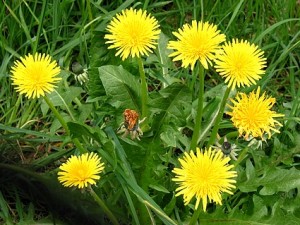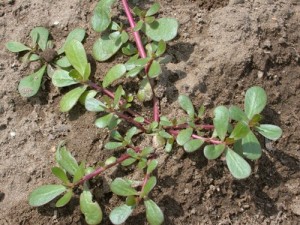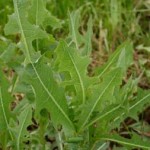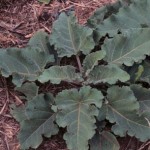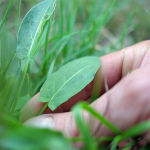
When most people look at the rangy, tenacious invaders in their lawns, gardens, and cracks in the pavement, they see a problem to be handled by digging, pulling, cursing, and spraying with herbicides. Weeds seem to follow us and insinuate themselves into every bit of disturbed soil and manicured garden imaginable. They are the bane of the perfectionist’s outdoor experience. But what if these invaders are, in fact, a vast, untapped nutritional resource?
As it turns out, most of what we consider weeds are either edible or have medicinal qualities. Really the idea that a lawn should be a perfectly-manicured monoculture of Kentucky bluegrass is a concept manufactured post-WWII: the personal display of prosperity. A century ago clover (a nitrogen fixer and soil fertility enhancer) was included in grass seed mixtures and dandelions were considered a salad green. Now, suburban lawns rival golf courses in the application of chemical herbicides and insecticides, not to mention the water consumption and pollution produced by lawnmowers in the maintenance of these toxic green wastelands.
The never-ending task of pulling weeds becomes a lot more bearable when you realize that you are, in fact, harvesting a crop. With a little knowledge, you can craft a delicious salad from just these weeds from your yard. Please remember not to consume anything unless you are absolutely sure of its identity, as some plants can be toxic. The following is a description of the edible weeds that I find in my own backyard. This list is by no means exhaustive, but just a sample of my favorite weeds that are readily available here in Colorado, but are also widely distributed throughout the United States.
Let’s start with the humble and ubiquitous dandelion, reviled for its ability to send off millions of flying seeds and take over your yard. Dandelions (Taraxacum officinale) were imported to the North American continent by European settlers and have flourished here ever since. The leaves are good in salad and can be blanched to remove the bitterness. I enjoy sprinkling a few of these in my salads, but they can also be boiled as you would with spinach. The greens are very high in vitamins, especially K, A, and C. I find that the smaller, newer leaves are less bitter. The taproots can be made into tea which is traditionally used as a diuretic. The flowers can also be eaten or be used to make dandelion wine.
Next, we have the delicious lamb’s quarters (Chenopodium album). I have a large patch of these growing in an otherwise-barren patch of my yard. This plant is extensively cultivated in India as a crop. The leaves are not overly bitter and taste much like spinach. They can be either cooked or eaten raw, but should only be consumed in moderation, as they are high in oxalic acid. The seeds are high in protein and minerals and can be prepared as a grain. I have never tried this, but will see what happens when my lamb’s quarters decide to go to seed.
Perhaps my favorite edible weed is purslane (Portulaca oleracea ). This succulent is not only tasty, but also a superfood. It contains more omega-3, mainly found only in fish, than any other green vegetable. It also contains vitamins A, B, and C, as well as minerals such as magnesium, potassium, calcium, and iron. You typically will find purslane inhabiting dry, rocky clay soil such as rock gardens and patios. It looks like a small, sprawling jade plant. The taste is mild, tangy and slightly salty. Purslane can also be cooked and is often used as a thickener in Mexican food, similar to okra in Cajun food. Personally, I have only used purslane fresh in salads. I find that the stems can get tough once the plant has bloomed, but the leaves can still add a tangy crunch to a salad.
Another common weed here in the Midwest is prickly lettuce (Lactuca serriola). The leaves grow along a spiny stem and get progressively smaller as they reach its top.
It is a close relative of cultivated leaf lettuce and can even cross pollinate with it. This is far more bitter than the lettuce that you find in the store, but the small tender leaves are more palatable.
There are numerous species of wood sorrel (Oxalis) that have been consumed by humans around the world for millennia. The particular variety that I find in my yard is common yellow wood sorrel (Oxalis stricta). This plant has 3 heart-shaped leaves, similar to clover, with the notable difference that clover leaves are round with white markings. The edible parts of wood sorrel are the leaves and young seed pods which are very tart and lemony in taste. When used in a salad, the tartness of the wood sorrel nicely offsets the bitterness of other greens such as dandelion and prickly lettuce. Wood sorrel is a good source of vitamin C, but is high in oxalic acid and should be used somewhat sparingly.
The species of weeds I have discussed here so far are all harvested primarily for their greens, but another common weed is useful as a root vegetable. Burdock (Arctium lappa), a relative of thistle and artichoke, is popular in Asia for its tuberous roots. It is gaining popularity here in the US as part of the macrobiotic diet. The roots can be sliced thin and parboiled to remove the bitterness. I have some of this growing in my yard but have never tried it. It is reported to be delicious, so I will be looking into recipes and preparation techniques this summer before I harvest it.
Imagine yourself preparing a lovely fresh salad from just the plants listed above. I think a tangy raspberry or balsamic vinaigrette compliments the flavors of the wild greens nicely. If these wild greens have too much flavor for your taste, you can easily mix in some iceberg or romaine lettuce. The list above describes just the edible wild plants in my own yard. There are so many other edible plants found in the wild throughout the US such as fiddlehead ferns, kudzu, ramps, cattails, and plantain, not to mention all of the many wild berries and nuts. You can contact your local extension office for more information about edible weeds in your area. There are also urban foraging classes available. Please remember not to forage from a lawn or garden where pesticides or herbicides have been applied. Also, it is unwise to eat plants growing close to a busy street, as they may absorb pollutants from car exhaust.
With a little knowledge, you too can take advantage of nature’s abundance of free nutrition and begin to see weeds in a whole new light.
